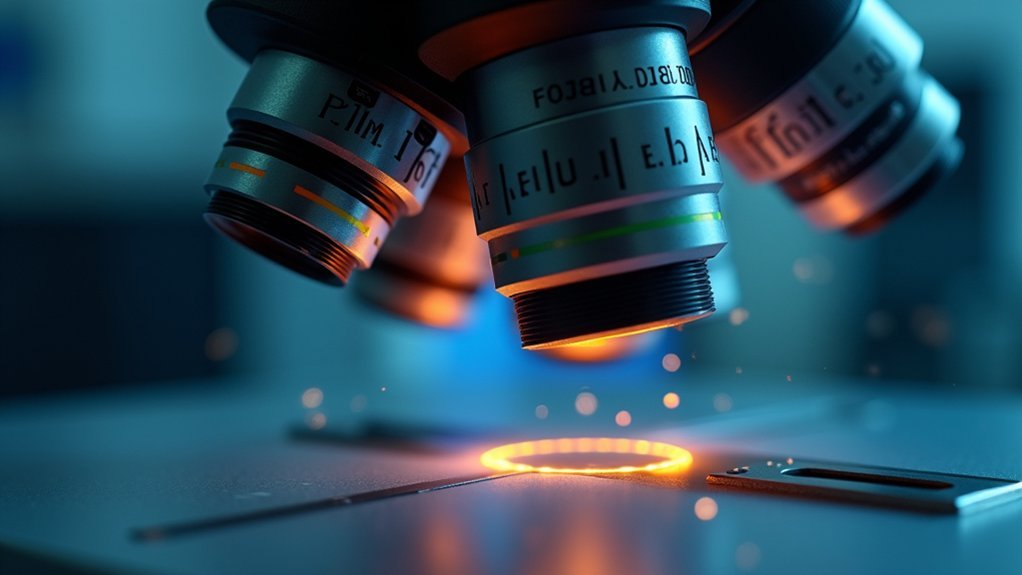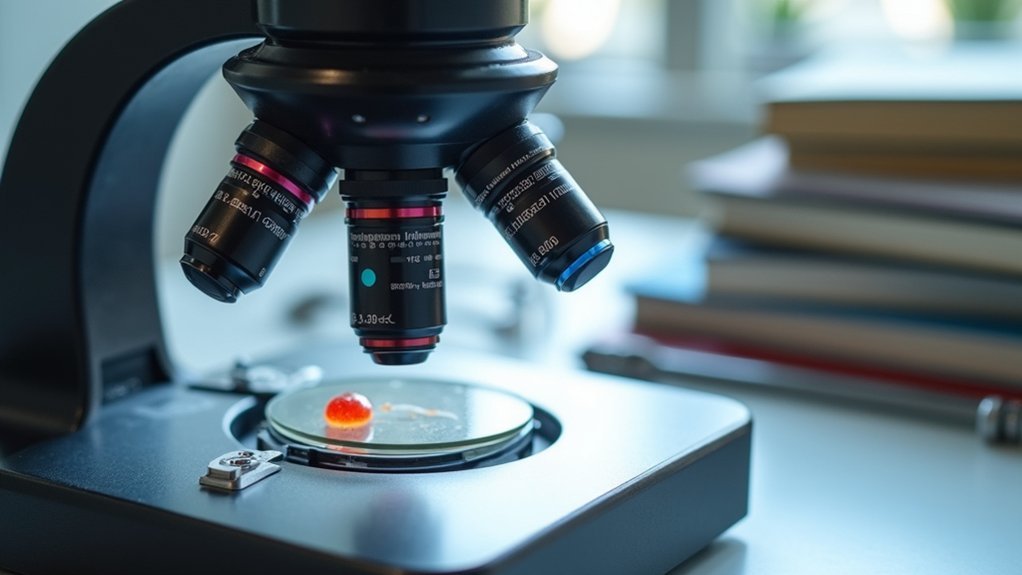For ideal objective parfocal setup: 1) Match parfocal lengths (45mm for DIN, 36mm for JIS) to minimize refocusing; 2) Use your 10X objective as the reference point for calibration; 3) Adjust each higher power objective using the parfocal adjustment ring; 4) Handle objectives by the outer barrel to prevent misalignment; 5) Secure adjustments with optical cement after calibration. These precise alignment techniques guarantee crisp imaging across all magnifications.
Understanding Parfocal Distance and Its Importance

When you’re switching between objectives on your microscope, nothing disrupts workflow more than having to completely refocus with each change. That’s where parfocal distance becomes essential. This specific measurement represents the consistent distance between objective lenses and your specimen that maintains focus across different magnifications.
Your microscope’s parfocal length—typically 45mm for DIN objectives or 36mm for JIS objectives—is designed to enhance workflow efficiency during multi-objective microscopy. By maintaining proper parfocal distance, you’ll achieve clearer high-resolution images without constant adjustments.
Regular checks of your system’s parfocality prevent image distortion and guarantee peak performance. This is particularly important when working with multiple objectives at varying magnifications, as even slight deviations can compromise image quality and notably slow down your microscopy work.
Selecting Compatible Objectives for Seamless Focus Transitions
Achieving true parfocality begins with selecting the right combination of objectives for your microscope. When assembling your parfocal setup, you’ll need to guarantee your objective lenses work together harmoniously to maintain focus stability across different magnifications.
- Match parfocal lengths – Choose objectives that share standardized parfocal lengths (45mm for DIN or 36mm for JIS) to minimize refocusing when switching magnifications.
- Consider working distance compatibility – Longer working distances can affect parfocality, so select objective lenses with complementary working distances.
- Arrange logical magnification progression – Start with lower powers (10X) and progress to higher magnifications (40X, 100X) for ideal focus shifts.
- Maintain optical consistency – Select objectives with similar optical characteristics (achromatic design) and appropriate numerical aperture values to guarantee consistent image quality across all magnifications.
Step-by-Step Calibration Technique for Perfect Alignment

After selecting your compatible objectives, it’s time to precisely align them for true parfocality.
Begin calibration by keeping only the 4X or 10X objective on your microscope as your reference point. Remove higher power objectives and unscrew their outer covers to access the parfocal adjustment ring, gently dissolving any optical cement with acetone.
Focus sharply on a specimen using your 10X objective, then switch to the next higher power objective without touching the focus knobs. Adjust the ring until the image appears crisp.
Repeat this process for each higher power objective in sequence.
Once alignment is complete, you can secure the adjustment ring with optical cement or clear nail polish. Let it dry thoroughly before reassembling and reinstalling the objectives in your microscope for seamless shifts during observations.
Maintaining Parfocal Performance With Proper Handling
The longevity of your microscope’s parfocal alignment depends greatly on how you handle the objectives during regular use. Proper maintenance guarantees consistent focus across all magnifications without readjustment.
- Always grip the outer barrel when handling objectives to prevent disturbing internal components that maintain parfocal alignment.
- Clean lenses regularly to remove dust and debris that can compromise image quality and parfocal performance.
- Switch between objectives gently without applying excessive force, as rough handling can misalign parfocal settings.
- Store objectives properly in protective cases when not in use, and periodically test parfocality by confirming that all objectives maintain focus when rotated into position.
Remember that even minor mishandling can affect parfocal performance, requiring time-consuming recalibration to restore proper alignment.
Troubleshooting Common Parfocal Alignment Issues

Even with proper handling and maintenance, parfocal issues can still emerge during regular microscope use. If you’re struggling to maintain focus when switching between objectives, check your parfocal adjustment ring for optical cement or debris that might be restricting movement.
Always begin troubleshooting by establishing focus with your lower power objective before moving to higher power objectives. This creates a reliable baseline for adjustments.
When higher power objectives consistently appear out of focus, verify they’re installed in the correct order.
Watch for misalignment caused by wear and tear on the microscope body or objectives themselves. For precise calibration during troubleshooting, use a stage micrometer or standard reference object to confirm all objectives align to the same focal point.
This systematic approach will help resolve most parfocal alignment problems efficiently.
Frequently Asked Questions
How Do You Adjust a Microscope for Optimal Viewing?
You’ll get ideal microscope viewing by calibrating with lower objectives first, ensuring proper focus, then adjusting higher magnifications. Don’t forget to adjust lighting, aperture, and contrast for clear specimen observation.
Why Should You Always Begin Focusing on a Specimen With the 4x Objective Lens in Place?
You should always begin with the 4x objective because it gives you a wider field of view, greater working distance, and provides an ideal starting point for parfocal shifts to higher magnifications.
What Should You Always Do Before Moving to a Higher Objective Lens for Viewing?
Before moving to a higher objective lens, you should guarantee your specimen is properly illuminated and in focus with the lower objective. This provides a clear reference point that’ll minimize adjustments needed after switching.
What Are the Objective Lenses 4x, 10X, 40X, and 100X Used During?
You’ll use 4x to scan and locate areas of interest, 10x for general observation, 40x to view cellular structures with higher detail, and 100x (oil immersion) to see minute structures like bacteria.
In Summary
Parfocal alignment isn’t just a convenience—it’s essential for efficient microscopy. By following these five steps, you’ll guarantee smooth shifts between objectives without constant refocusing. Remember to select compatible objectives, calibrate them properly, handle your equipment with care, and address alignment issues promptly. With these practices in your workflow, you’ll save time and obtain more consistent, reliable imaging results in your microscopy work.





Leave a Reply